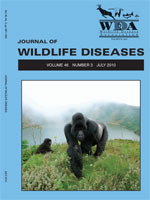We used enzyme-linked immunosorbent assay (ELISA) and western blotting (WB) to evaluate the reactivity of first-stage larval extracts of Hypoderma lineatum with antibodies in sera from 76 red deer from an endemic area for Hypoderma actaeon. Antibodies in sera from deer infested with H. actaeon recognized hypodermin C from H. lineatum in both ELISA and WB assays. ELISA values were correlated with the epidemiology of the fly infestation in the area where the deer sera were collected. There was no clear relationship between anti-hypodermin C antibody levels and the age of the animals or the number of Hypoderma grubs found at necropsy in the hides of the deer. Our results suggest that first-instar antigens of H. lineatum can be used to diagnose natural infestations by H. actaeon by indicating the presence of first-stage larvae, which can help to accurately describe H. actaeon epidemiology.
How to translate text using browser tools
1 July 2010
Detection of Hypoderma actaeon Infestation in Cervus elaphus with ELISA and Western Blotting
Julia Domínguez,
Rosario Panadero,
Concepción de la Fuente-López
ACCESS THE FULL ARTICLE

Journal of Wildlife Diseases
Vol. 46 • No. 3
July 2010
Vol. 46 • No. 3
July 2010
diagnosis
ELISA
Hypoderma
red deer
Western blotting




